Avatary Studio: Difference between revisions
| Line 86: | Line 86: | ||
==== Graphic Tutorial ==== | ==== Graphic Tutorial ==== | ||
# Easily import the video material. Select the desired video file in the resource manager and directly drag it to the timeline area of the software. Immediately, a window will pop up. In this window, accurately select the "With-Track" option to start the subsequent specific tracking process. | |||
# After entering the "'''With-Track'''" dedicated window, you will be faced with a variety of point cloud templates. Please make a careful choice. We highly recommend that you give priority to the AI04 or AI06 templates, which have been optimized to provide a more accurate and reliable data foundation for subsequent analysis. | |||
# Locate the '''"A" button''' at the bottom left corner of the software. Click it decisively, and the software will automatically invoke advanced algorithms to attentively analyze the subtle facial features in the video, laying the groundwork for subsequent precise matching. | |||
# Wait for a while. Once the analysis process is successfully completed, you can easily switch to the Avatary Studio interface. Here, detailed and intuitive analysis results are ready for you to view and evaluate, so that you can decide the next operation direction. | |||
# Move your eyes upward. In the top menu bar of the Avatary Studio software, accurately find and click to switch to the '''"Retargeter" mode'''. This mode is a crucial bridge connecting the software with external digital content creation (DCC) tools, unlocking more in-depth editing functions. | |||
# Follow the '''established connection''' specifications to smoothly connect to the DCC software you need. Ensure that the connection is stable and reliable, which is the cornerstone for seamless data interaction and efficient collaboration. | |||
# After successfully connecting to the DCC, focus on the right panel of the software, find and click the '''"Auto Pose" option'''. It is like an intelligent assistant that can quickly generate basic pose data to facilitate subsequent fine adjustments. | |||
# Immediately after that, click the adjacent '''"view more" button''', opening a door to more abundant settings and presenting more possibilities for personalized customization. | |||
# In the newly popped-up '''"solver edit" window''', carefully sort through the grouping options and accurately select the key facial area groups, such as "Brow", "Eye", "Mouth", etc., to enable refined manipulation of different parts. | |||
# After selecting one of the groups, '''quickly switch to the connected DCC software''' interface and use the lasso tool flexibly to accurately select the model controllers corresponding to this group. This step is like building a communication bridge to ensure that commands are accurately conveyed. | |||
# Return to the '''"solver edit"''' window again and click the crucial '''"Update" button'''. At this moment, the software will intelligently capture the controller information you selected in the DCC, achieving data synchronization and laying a solid foundation for subsequent calculations. | |||
# Click the '''"Save" button''' to promptly save the current carefully set data state, preventing accidental loss and ensuring the continuity and stability of the work process. | |||
# Repeat steps 10 to 12, methodically switching to other groups and completing the same refined settings and data synchronization operations one by one to ensure that all key parts of the entire model can be precisely controlled. | |||
# When all group settings are completed, decisively close the "solver edit" window and seamlessly switch to the '''"Manual Pose" mode'''. This mode gives you more freedom for manual manipulation to meet personalized creative needs. | |||
# Move your sight back to the bottom left corner of the software. In the clear grouping option area, flexibly select a specific group according to your creative needs, preparing to focus on the detailed refinement of keyframes. | |||
# Manipulate the timeline as if traveling through the video time corridor to accurately select keyframes. During the process, you can use the conveniently placed '''"+" and "-" buttons''' above the timeline to add or delete keyframes as you wish, achieving the perfect optimization of the frame sequence. | |||
# Switch to the "Manual Pose" mode interface, and you will be pleasantly surprised to find that the carefully selected keyframes have been prominently marked with '''red fonts''', making it convenient for you to quickly locate and operate them. | |||
# Lightly click on one of the red keyframes. Magically, the corresponding DCC software interface will instantly and automatically jump to the corresponding time position, achieving precise synchronization across interfaces and greatly improving operational efficiency. | |||
# At this moment, in the DCC software, give full play to your creativity and skills to finely adjust the model controllers. Carefully compare the facial expression details in the video frame and make the model expression perfectly match it, giving the character vivid vitality. | |||
# After the adjustment is completed, return to the Avatary Studio interface and click the crucial '''"G" button'''. The software will intelligently capture the current controller values, completing the key data collection and injecting soul into subsequent calculations. | |||
# Instantly, you will notice that the keyframe you just operated on has changed from '''red to yellow''' in the "Manual Pose", visually indicating that it has successfully collected data and is waiting for the next calculation instruction. | |||
# The rest of the keyframes follow the same process, giving them precise controller data and unique personalities one by one. | |||
# Click the '''"M" button''', and the software will go full throttle, using complex algorithms to conduct in-depth calculations on all keyframes and controller data, weaving a data association network and laying a solid foundation for the perfect presentation of results. | |||
# After the calculation is completed, the timeline will be transformed gorgeously. The dynamic curves of each controller will be clearly presented, like the beating pulse of data. At the same time, the keyframes participating in the calculation will shine with a '''green light''' in the "Manual Pose", announcing the successful calculation and data readiness. | |||
# Finally, click the "'''Synchronize to DCC" button''' on the timeline. The software will quickly and accurately transmit the calculation results to the DCC software like a courier, ensuring seamless data connection at both ends. | |||
# Wait patiently for the short transmission process to end. Return to the DCC software interface again. At this moment, the stunning effect that perfectly combines video and model data has been fully presented for you to appreciate, evaluate, and further refine in your creation. | |||
=== No-Track === | === No-Track === | ||
Revision as of 08:00, 17 December 2024

Avatary Studio is a new generation of high-precision facial expression post-processing software that can convert facial expression videos shot by any camera into high-quality 3D facial expression animations and supports any 3D facial expression rigging system. The high-precision facial expression animations calculated by Avatary Studio can be exported to mainstream DCC (digital content creation) software such as Maya, 3ds Max, Blender, Unreal, Unity and MotionBuilder.
DOWNLOAD NOW!!!
Avatary Studio, with its unique ingenuity, spares no effort to safeguard your asset security!
It pioneers an architecture that separates computing nodes from assets, completely eliminating
the hassle of asset migration and firmly protecting every piece of digital asset.
Currently supported DCC versions:
- Maya 2020
- Maya 2022
- Maya 2023
- 3Ds Max 2022
TODO List:
- MotionBuilder
- UE
- Unity
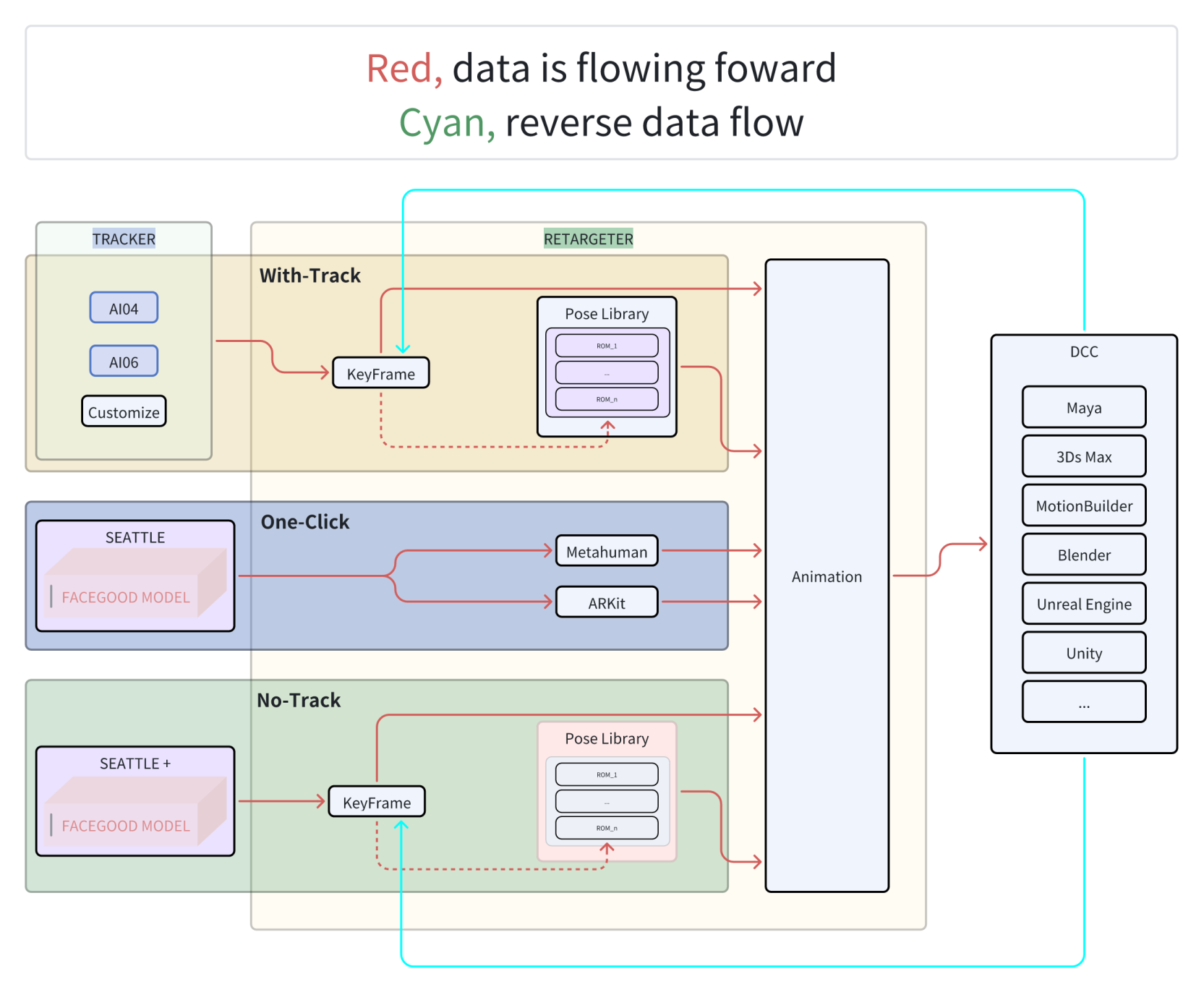
Quick Intro
Log in to Avatary Studio
- Open Avatary Studio and enter your account to log in at the login screen
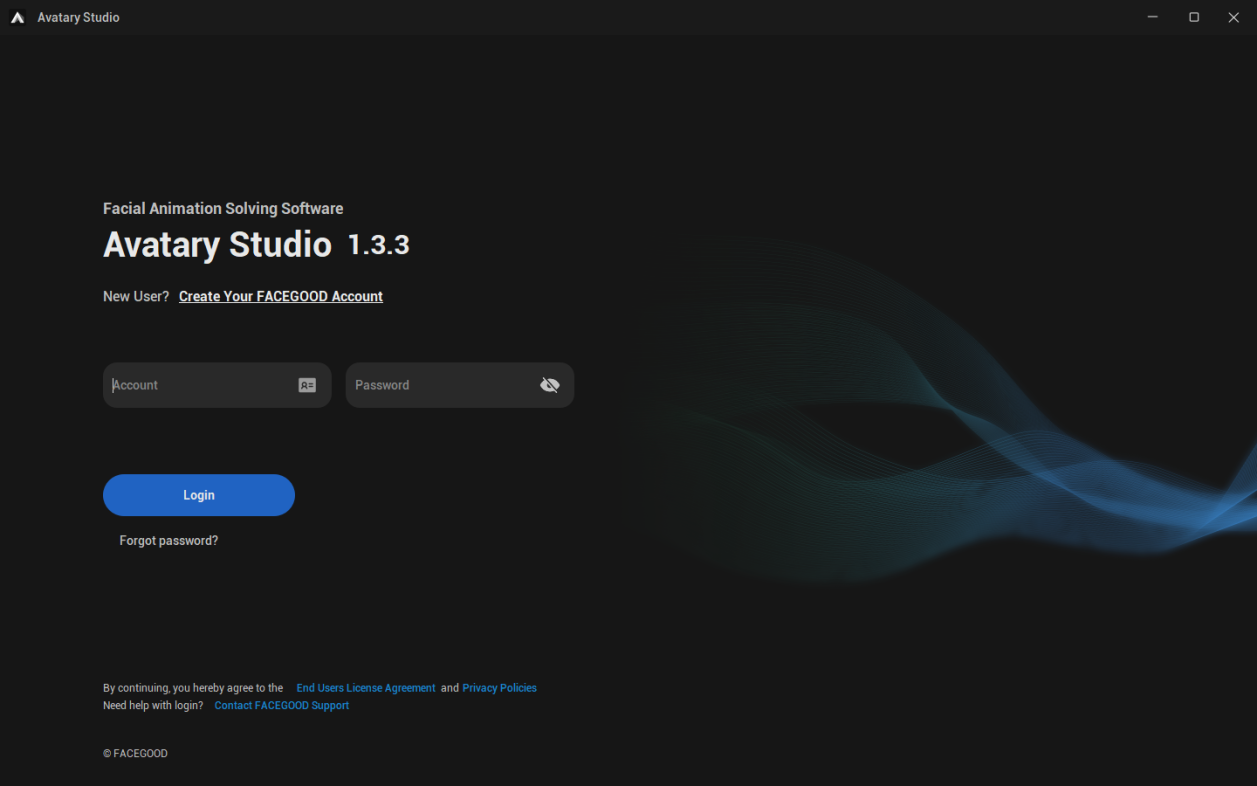
Create new local project
- Locate and click the "Create Project" button to initiate the project creation process. This button is usually prominently placed on the software interface for your easy access.
- In the pop-up dialog box, accurately enter the project path, that is, specify the exact location where you want to store the project files. Then enter a unique project name. Once you've finished inputting, click the "Create" button.
NOTE: At this point, the system will automatically create a dedicated folder named after the project name under the specified project path, which is used to store various data and files related to this project, ensuring orderly management of project resources.
- After the project is successfully created, you can simply switch to the "Recently Used Projects" list area and immediately find the newly created project, allowing you to quickly start subsequent project operations and seamlessly connect to the workflow.
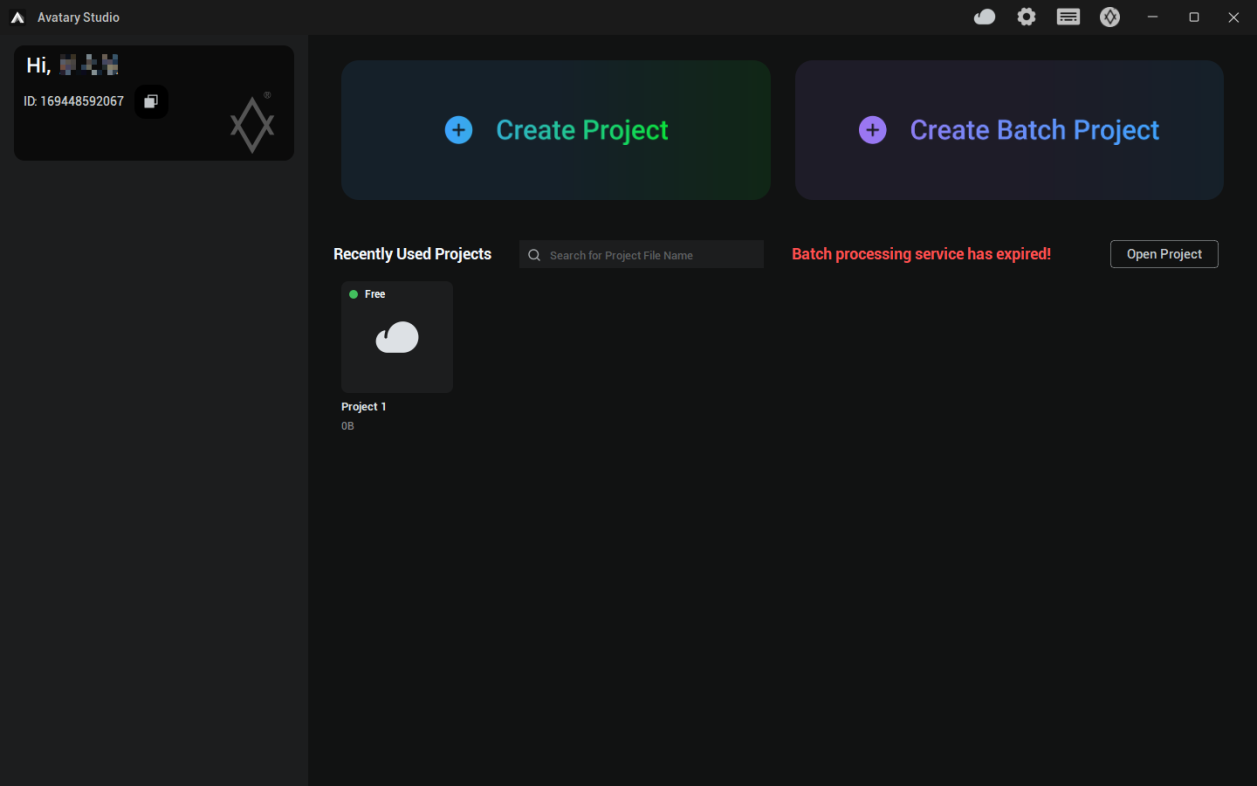
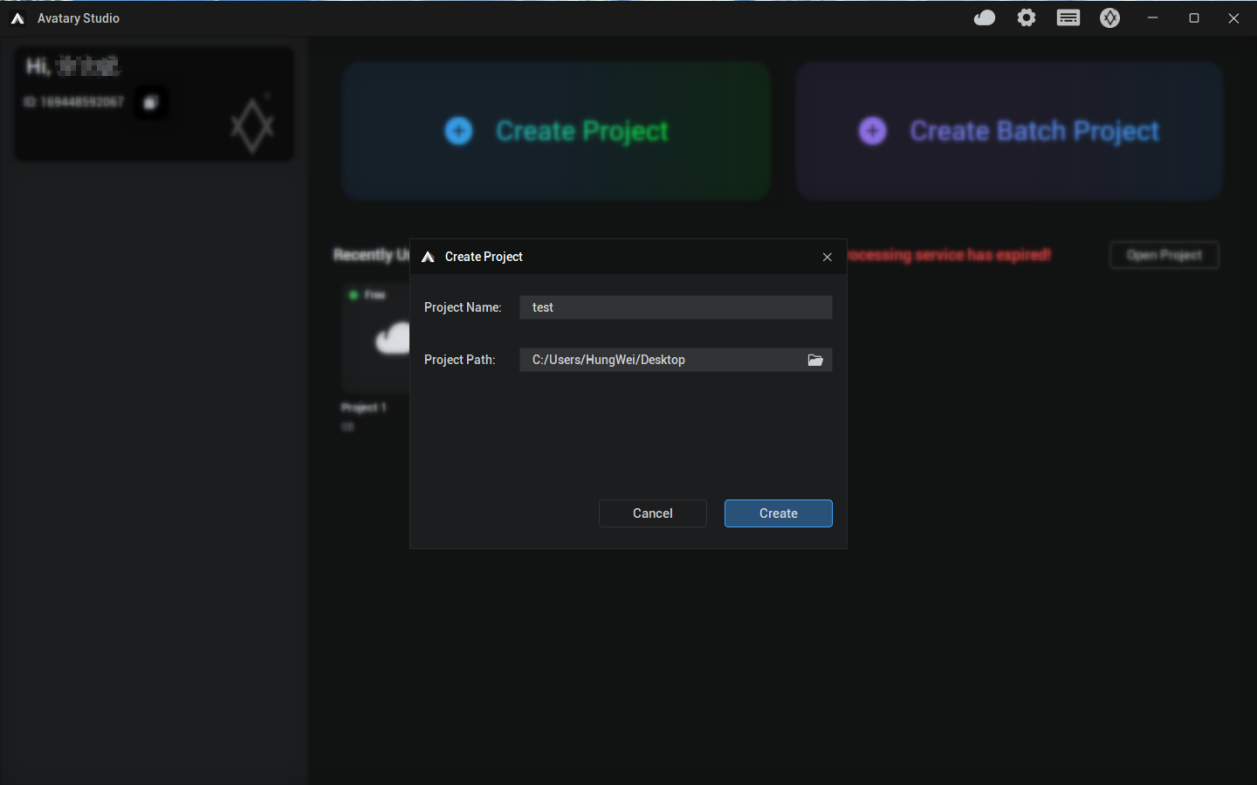
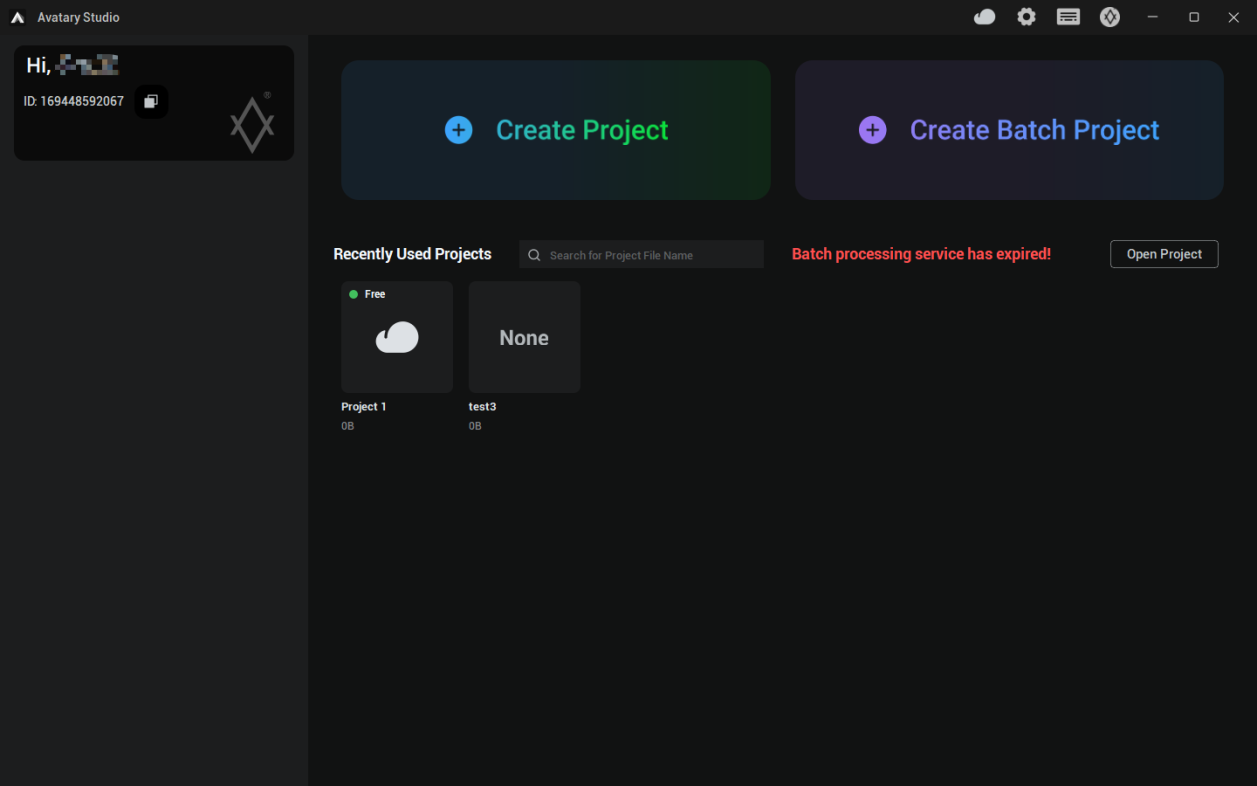
Import video to project
- If you want to import video files, simply drag the video directly into the resource manager.
NOTE: Please note that currently the system only supports video files in .mov and .mp4 formats. If the format of the video you selected does not match, the dragging operation cannot be completed. Please confirm whether the video format is correct in advance.
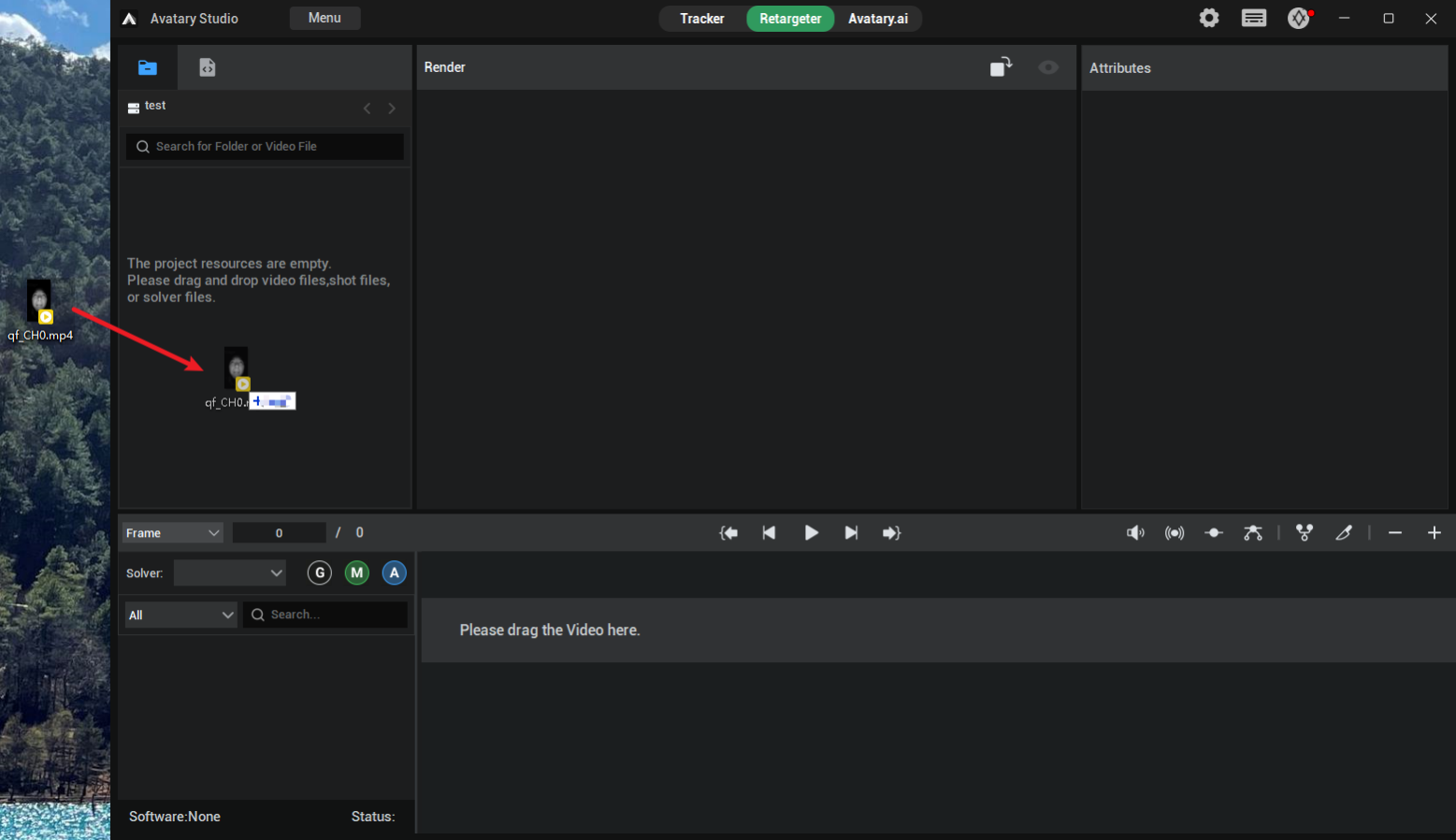
Connect to DCC
- Embark on the connection journey by first locating the prominent settings button on the Avatary Studio interface, which is in the shape of a gear, and click it gently.
- Subsequently, in the "Target" item column of the pop-up settings menu, carefully select the installed and supported version of the DCC software.
- Then, toggle the "Connect" button to the on state, getting ready for the subsequent docking.
- After completing the first step, open the corresponding DCC software. At this moment, simply shift your gaze to the menu bar area of this software, and you will find the dedicated Avatary Studio plugin listed there. Click to open this plugin and then further locate and click the "start" button to activate the preliminary communication link between the software.
- Wait patiently for a while and closely watch the "Status" indicator light at the bottom left corner of Avatary Studio. Once it changes smoothly from the conspicuous red to the refreshing green, it means that you have successfully established the connection between the two. Congratulations!
Note: During the entire usage process, when you don't need to operate the Avatary Studio plugin within the DCC software, never close it directly. Instead, minimize it to the taskbar. This way, you can ensure the connection remains stable, avoid unnecessary repeated connection operations, and enhance your work efficiency.
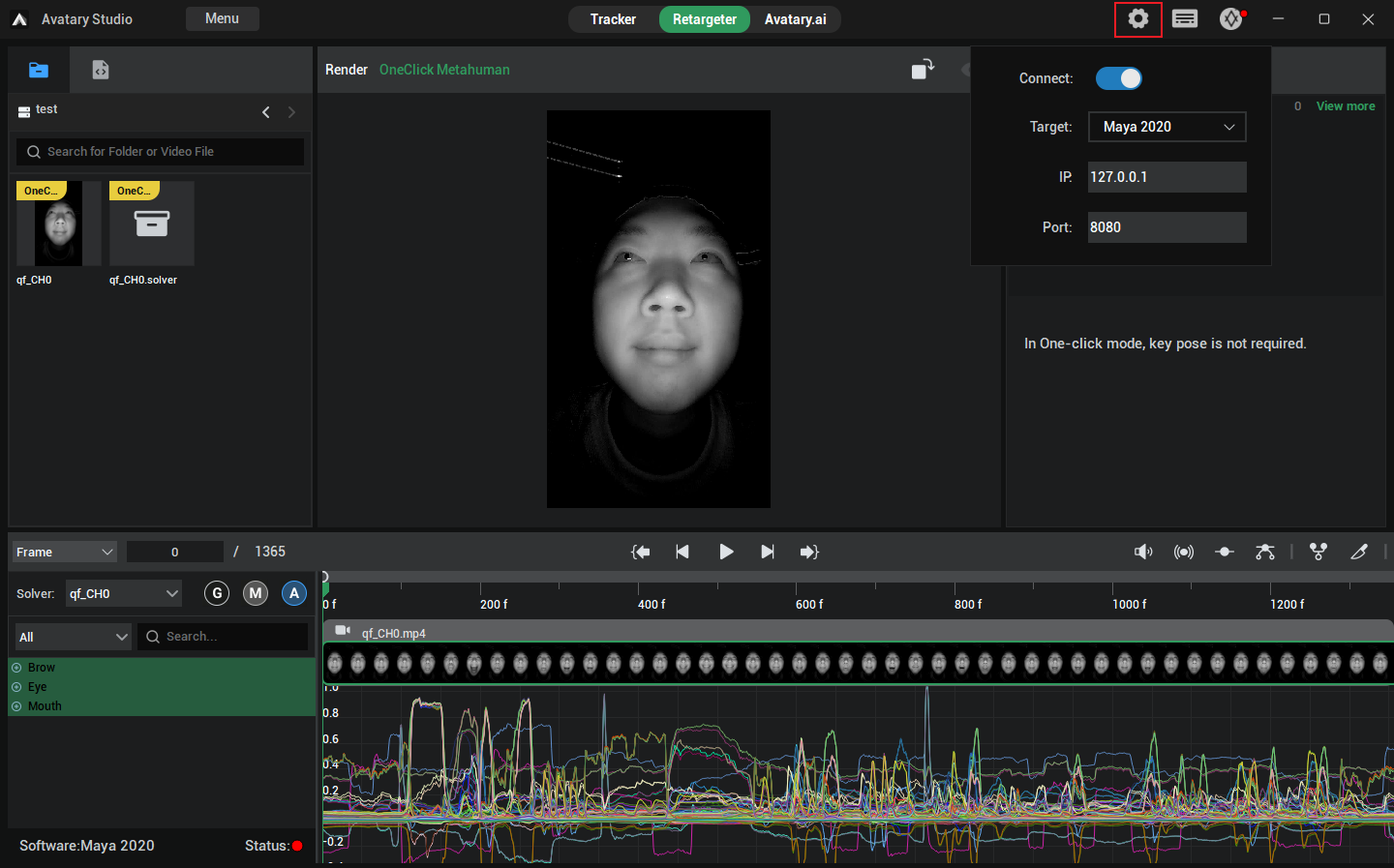
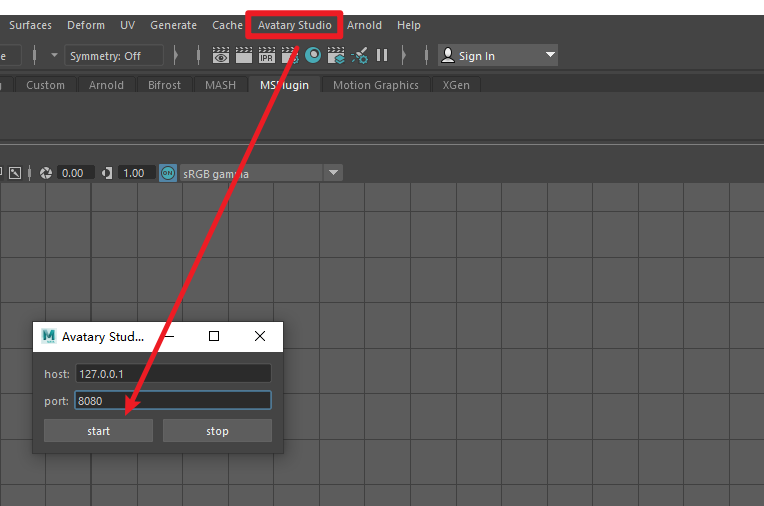
Solver Mode
With-Track
Video Tutorial
Graphic Tutorial
- Easily import the video material. Select the desired video file in the resource manager and directly drag it to the timeline area of the software. Immediately, a window will pop up. In this window, accurately select the "With-Track" option to start the subsequent specific tracking process.
- After entering the "With-Track" dedicated window, you will be faced with a variety of point cloud templates. Please make a careful choice. We highly recommend that you give priority to the AI04 or AI06 templates, which have been optimized to provide a more accurate and reliable data foundation for subsequent analysis.
- Locate the "A" button at the bottom left corner of the software. Click it decisively, and the software will automatically invoke advanced algorithms to attentively analyze the subtle facial features in the video, laying the groundwork for subsequent precise matching.
- Wait for a while. Once the analysis process is successfully completed, you can easily switch to the Avatary Studio interface. Here, detailed and intuitive analysis results are ready for you to view and evaluate, so that you can decide the next operation direction.
- Move your eyes upward. In the top menu bar of the Avatary Studio software, accurately find and click to switch to the "Retargeter" mode. This mode is a crucial bridge connecting the software with external digital content creation (DCC) tools, unlocking more in-depth editing functions.
- Follow the established connection specifications to smoothly connect to the DCC software you need. Ensure that the connection is stable and reliable, which is the cornerstone for seamless data interaction and efficient collaboration.
- After successfully connecting to the DCC, focus on the right panel of the software, find and click the "Auto Pose" option. It is like an intelligent assistant that can quickly generate basic pose data to facilitate subsequent fine adjustments.
- Immediately after that, click the adjacent "view more" button, opening a door to more abundant settings and presenting more possibilities for personalized customization.
- In the newly popped-up "solver edit" window, carefully sort through the grouping options and accurately select the key facial area groups, such as "Brow", "Eye", "Mouth", etc., to enable refined manipulation of different parts.
- After selecting one of the groups, quickly switch to the connected DCC software interface and use the lasso tool flexibly to accurately select the model controllers corresponding to this group. This step is like building a communication bridge to ensure that commands are accurately conveyed.
- Return to the "solver edit" window again and click the crucial "Update" button. At this moment, the software will intelligently capture the controller information you selected in the DCC, achieving data synchronization and laying a solid foundation for subsequent calculations.
- Click the "Save" button to promptly save the current carefully set data state, preventing accidental loss and ensuring the continuity and stability of the work process.
- Repeat steps 10 to 12, methodically switching to other groups and completing the same refined settings and data synchronization operations one by one to ensure that all key parts of the entire model can be precisely controlled.
- When all group settings are completed, decisively close the "solver edit" window and seamlessly switch to the "Manual Pose" mode. This mode gives you more freedom for manual manipulation to meet personalized creative needs.
- Move your sight back to the bottom left corner of the software. In the clear grouping option area, flexibly select a specific group according to your creative needs, preparing to focus on the detailed refinement of keyframes.
- Manipulate the timeline as if traveling through the video time corridor to accurately select keyframes. During the process, you can use the conveniently placed "+" and "-" buttons above the timeline to add or delete keyframes as you wish, achieving the perfect optimization of the frame sequence.
- Switch to the "Manual Pose" mode interface, and you will be pleasantly surprised to find that the carefully selected keyframes have been prominently marked with red fonts, making it convenient for you to quickly locate and operate them.
- Lightly click on one of the red keyframes. Magically, the corresponding DCC software interface will instantly and automatically jump to the corresponding time position, achieving precise synchronization across interfaces and greatly improving operational efficiency.
- At this moment, in the DCC software, give full play to your creativity and skills to finely adjust the model controllers. Carefully compare the facial expression details in the video frame and make the model expression perfectly match it, giving the character vivid vitality.
- After the adjustment is completed, return to the Avatary Studio interface and click the crucial "G" button. The software will intelligently capture the current controller values, completing the key data collection and injecting soul into subsequent calculations.
- Instantly, you will notice that the keyframe you just operated on has changed from red to yellow in the "Manual Pose", visually indicating that it has successfully collected data and is waiting for the next calculation instruction.
- The rest of the keyframes follow the same process, giving them precise controller data and unique personalities one by one.
- Click the "M" button, and the software will go full throttle, using complex algorithms to conduct in-depth calculations on all keyframes and controller data, weaving a data association network and laying a solid foundation for the perfect presentation of results.
- After the calculation is completed, the timeline will be transformed gorgeously. The dynamic curves of each controller will be clearly presented, like the beating pulse of data. At the same time, the keyframes participating in the calculation will shine with a green light in the "Manual Pose", announcing the successful calculation and data readiness.
- Finally, click the "Synchronize to DCC" button on the timeline. The software will quickly and accurately transmit the calculation results to the DCC software like a courier, ensuring seamless data connection at both ends.
- Wait patiently for the short transmission process to end. Return to the DCC software interface again. At this moment, the stunning effect that perfectly combines video and model data has been fully presented for you to appreciate, evaluate, and further refine in your creation.
No-Track
Video Tutorial
Graphic Tutorial
One-Click
Video Tutorial
Graphic Tutorial
Cloud Batch Solver
Video Tutorial
FAQ
The software cannot be opened.
Install the vc_redist.x64.exe program in the installation directory of Avatary Studio.
The calculation cannot be carried out in Avatary Studio, or the software crashes during the calculation process.
Please install CUDA 11.8.
The Avatary Studio plugins cannot be found in the DCC.
Please check whether the installation directory of DCC in the registry is correct.
That is, go to the following location in the registry: HKEY_LOCAL_MACHINE\SOFTWARE\Autodesk\VaultQualified and check the installation directory of the corresponding version of DCC.

How to open the registry?
- Press the "Win + R" key combination. This shortcut will open the "Run" dialog box.
- In the "Run" dialog box, type "regedit" (which is the command for the Registry Editor), and then click the "OK" button or press the Enter key. After that, the Registry Editor will be opened. Its interface is similar to that of the File Explorer. On the left side is the tree structure of registry keys, and on the right side are the specific key values of the selected registry key.